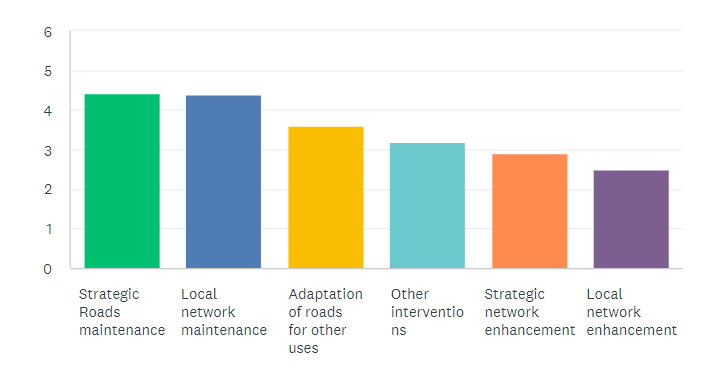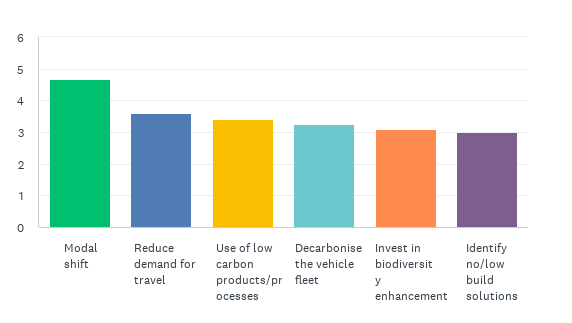
Ahead of the publication of the Third Road Investment Strategy (RIS3), we asked CIHT's members for their views on what the government’s goals from investment in roads should be, the problems and opportunities that need to be addressed, and the most promising routes to create a network that meets the future needs of users and society.
Join other savvy professionals just like you at CIHT. We are committed to fulfilling your professional development needs throughout your career
The Road Investment Strategy (RIS) is a financial planning tool used by the Department for Transport to allocate and manage fundings towards the Strategic Road Network in England and deliver its improvements meeting the social, economic, and environmental aspirations that the nation has.
The investment plan is developed every 5 years through the collaboration of the following bodies:
Two strategies have been developed so far, RIS1, running from April 2015 until March 2020, and RIS2, currently taking place and ending in March 2025.
The department and National Highways are currently developing the Third Road Investment Strategy through a three-phase process that consists in:
As the research phase came to an end and the public consultation will soon be open, we reflected on the lessons learned from the previous and current RISs and we engaged with our membership to identify key areas of interest that should be addressed in the next strategy. In February 2023 we conducted a survey that received 154 responses. Below are some interesting insights on the future of road investments and the directions that our members would like CIHT to take on major topics.
Respondents identified 3 major objectives for RIS3:
Maintenance of both the strategic road network and local roads were the main priorities for budget allocation.
74% of respondents would support the introduction of a Road User Charging System.
To improve safety on our future roads, respondents indicated two priorities:
Our members identified modal shift as the main path to achieve Net Zero.
In 2021, the Department for Transport published “Planning ahead for Strategic Road Network: developing the third road investment strategy”, setting out 6 initial objectives for RIS 3. We asked our members to rank these objectives from 1 to 6 according to their importance ( 1= higher importance; 6= lower importance):
47.50% of respondents rated "Improving safety for all" as the top priority, followed by "Improving environmental outcomes", ranked as second in the priority list by 23.75% of respondents.
When asked to provide comments or additional objectives, respondents highlighted the need to support the transition towards decarbonisation, active travel and a more sustainable transport system where car mileage is reduced:
Focusing on reducing embodied carbon within the management, maintenance and operation of the highway network.
Survey respondent
Enabling more of Active Travel. While I appreciate this is more a matter for local networks, some of the SRN falls within towns and cities, and where it does it tends to present a barrier, rather than a route, to active travel.
Survey respondent
Supporting transition to a sustainable transport system, away from private use vehicles. Supporting a transition to a reduction in private vehicles.
Survey respondent
Sensibly, comments also noted the need integrate the Local Road Network with the Strategic Road Network to improve social equality and economic opportunities through regional connectivity (adapted from respondent's answer).
We asked our members how they would allocate financial resources across a pot of activities on the whole road network (strategic and local roads) with a scale of 0=low priority, 6= high priority:

It is clear from these results how professionals in the sector consider maintenance essential to ensure that the physical conditions of our road infrastructure are at the highest levels.
26.25% of respondents indicated "Maintenance of the Strategic Network" has the highest priority. As most journeys happen on local roads, 28.75% of respondents attributed to "Maintenance of local roads" the second position.
Among "other interventions", respondents highlighted again the need to concretely address climate change impacts, not only through decarbonisation, but also infrastructure's adaptation:
...possibly linked with adaptation of roads for other uses, but improving amenity and biodiversity on and around the road network. With so many green spaces, verges etc that form part of the highway network this should be a main priority moving forward.
Survey respondent
We asked our members to rank a series of changes that we can invest in and adopt according to their contribution to improve environmental outcomes (0= lowest contribution; 6= highest contribution)

Using the Road Investment Strategy to drive modal shift and reduce overall demand for travel were members’ top priorities. This suggests that alongside a greater focus on maintaining the network, respondents would like to see resources committed to adapting the network to support other uses – or even that some funds should be diverted to helping people and business meet their needs for connectivity via means other than journeys by road.
74% of respondents said they would support the introduction of a Road User Charging System as an effective way to encourage the large-scale modal shift that we need.
Can be a good way to encourage active travel and reduced reliance on the car, especially for shorter journeys. A large part of the money raised should be reinvested in encouraging active travel (cycle provision, walking, e scooters etc) plus improving amenity, biodiversity and SuDS solutions on the network.
Survey respondent
However, respondents highlighted the equity and distributional impacts that such an introduction would bring to. As one respondent argues, it could "penalise those who are reliant on the use of the car where alternatives aren't available or affordable" and "cause intense frictions between road users and enforcing authorities".
During the current economic circumstances, with spiraling fuel costs and a wider cost of living crisis, a road user charging system should be considered in the context of a wider review of the existing road tax system, and better connect the use of funds to users' needs and expectations from the network.
Respondents highlighted the need for collaboration across disciplines in the design, appraisal and implementation of Road Investment Strategies. Respondents also highlighted a gap of skills and expertise in the appraisal process:
Weakness in collaborative working across disciplines. For example, getting …ecologists and engineers working together right from the outset on schemes, to better understand both environmental and engineering challenges and constraints to ensure any proposed solutions take all aspects into .
Survey respondent
It emerges from the survey that cost estimation, delivery planning, risk assessment and management are fields that National highways and the Department for Transport should review and improve ahead of the next strategy. Respondents call for updated data and decisions taken against current socio-economic evidence rather than historical trends.
Respondents were asked to rank interventions according to their impact on improving and ensuring safety on our future road (0=lowest impact;6=highest impact):
Respondents highlighted how the maintenance of the Strategic Road Network needs to be prioritised to ensure a high-quality network performance and safety. However, the highest priority is for "Safer road users", with 41.25% of respondent ranking it in first position. This requires considerations about road users education and behavior that goes beyond a focus on drivers and includes active travel and modal share.
Respondents also commented how education, from a young age, is necessary to support road safety.
Roads are to be designed to "naturally" encourage drivers to adjust their speed and be more aware of other users on the road….accident data show that the number of collisions is lower on motorways (where the speed limit is high) than on local roads…
Survey Respondent
When asked to choose which technology offered the greatest prospect of delivering better outcomes on the roads network, respondents ranked ‘digital journey planning’ the highest (on a scale of 0=low priority, 6=high priority).

28.75% of respondents ranked digital journey planning as the most prosperous technological solution, followed by the application of artificial intelligence (AI) in asset management.
Interestingly, respondents pointed out the need to focus technological solutions towards:
...energy infrastructure (supporting shift in vehicle fleet and mitigation of 'range anxiety') alongside better adoption and use of the data insights afforded by 'smart' infrastructure (including road user charging) to nudge user behavior.
Survey respondent
We are keen to discuss with our membership some points that we would like to see in the next strategy:
This is a key moment for the future of our roads and is taking place against a challenging backdrop that includes the legal requirement to meet decarbonisation targets, high inflation, difficulties in delivering the existing investment programme and uncertainty about future levels of demand. CIHT is ready to engage with National Highways and the Department for Transport to ensure that the next Road Investment Strategy meets the national economic, social and environmental goals.
CIHT advocates for the development of a National Transport Strategy, of which investments in the SRN should be a key point. The transition to a National Transport Strategy requires a comprehensive effort from the sector, where we move towards the integration of development and transport planning, different transport modes, local roads and the SRN- as highlighted in our ‘Better Planning, Better Transport, Better Places’ document.
Listen to our podcast with Steve Gooding, Visiting Professor at UWE Bristol and Director of the RAC Foundation, and Glenn Lyons, Chair of the Road Investment Scrutiny Panel.
"It's reasonable to raise the question when we look at the road investment history, about the make up of the voices, experience and mindsets that come into that judgement process.... and just simply as our report highlights the diversity of issues from decarbonisation to biodiversity, to social outcomes, to maintenance, as well as the economy, one quickly realises if there is a dearth of diversity in the conversation, in the decision-making there is a real risk the robustness of our decisions aren't meeting the standards we should expect for stewardship of the future”
Glenn Lyons
To read the report: Key questions for road investment and spending
If you want to know more about the survey or are interested in engaging with us on our consultations' responses, reach out to technical@ciht.org.
CPD is defined as any activity that provides new knowledge or skills that help you to achieve your professional development goals or has otherwise helped you to develop as a highways and transportation professional
Plan, record and manage your CPD for free at CIHT Learn.
Need help with getting the most out of your CPD access CIHT’s CPD Guidance here.
Sign up to the APM Newsletter.
{{item.AuthorName}} {{item.AuthorName}} says on {{item.DateFormattedString}}: